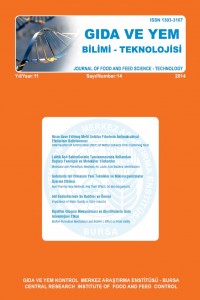Öz
Nisin, antimikrobiyal bir peptid olarak, etkili bir bakteriyel inhibitördür ve çeşitli yüzeylere absorbe olabilme özelliği nedeniyle, ambalaj materyallerine ilave edilebilmektedir. Bu çalışmada, çeşitli oranlarda
nisin içeren (500 IU, 1000 IU, 2000 IU ve 3000 IU/cm2 film) yenilebilir metil selüloz filmler hazırlanarak, invitro koşullarda, Listeria monocytogenes, E. coli, B. cereus, Salmonella Enteriditis ve S. aureus gibi önemli gıda kaynaklı patojenler üzerinde antimikrobiyal etkilerinin belirlenmesi amaçlanmıştır. Bu amaçla, hazırlanan nisin ilaveli metil selüloz filmlerden, 1 cm çapında diskler kesilerek, agar difüzyon yöntemi ile oluşan zon çapları ölçülmüştür. Yapılan analizler sonucunda, hazırlanan metil selüloz filmler, E. coli, B. cereus ve Salmonella Enteriditis’e
karşı herhangi bir antimikrobiyal etki göstermezken, 3000 IU/cm2 film oranında nisin içeren filmlerin, S.aureus üzerinde antimikrobiyal etki göstererek, 22.33±2.51 mm çapında zon oluşturduğu belirlenmiştir.
Hazırlanan tüm metil selüloz filmlerin, en güçlü antimikrobiyal etkiyi ise L. monocytogenes’e karşı gösterdiği tespit edilerek (sırasıyla 20.33±0.47; 22.33±0.47; 26±,1.00; 28.66±1.15 mm zon çapları) sonuçlar istatistiksel
olarak anlamlı bulunmuştur (P<0,05). Tüm analizler 3 tekerrürlü olarak gerçekleştirilmiştir.
Anahtar Kelimeler: Nisin, metil selüloz film, antimikrobiyel etki, aktif ambalajlama, patojen
Anahtar Kelimeler
Kaynakça
- Aktürkoğlu, E., Erol, İ., 1999. Beyaz Peynir Üretiminde Nisin Kullanımı ile Listeria monocytogenes’in İnhibisyonu. Tr.
- J. of Veterinary and Animal Science., 23(4):785-792.
- Ayana, B. 2007. Antimikrobiyel Yenilebilir Filmlerin Üretimi ve Özelliklerinin Belirlenmesi Mersin Üniversitesi, Fen
- Bilimleri Enstitüsü, Gıda Mühendisliği Anabilim Dalı, Yüksek Lisans Tezi, 60s., Mersin.
- Ayana, B., Turhan, N., 2010. Gıda ambalajlamasında Antimikrobiyel Madde İçeren Yenilebilir Filmler/Kaplamalar ve
- Uygulamaları. Gıda, 2: 151-158.
- Cao-Hoang, L., Chaine, A., Gregorie, L., Wache, Y., 2010. Potential of Nisin-İncorporated Sodium Caseinate Films to
- Control Listeria in Artifially Contaminated Cheese. Food Microbiology, 27:940-944.
- Campos, C.A., Gerschenson, L. N., Flores, S.K., 2011. Development of Edible Films and Coatings with Antimicrobial
- Activity. Food Bioprocess Technology, 4:849-875.
- Chi-Zhang Y., Yam K.L., Chikindas M. L. 2004. Effcetive control of Listeria monocytogenes by contamination of nisin
- formulated and slowly released into a broth system. Int. J. Food Microbiol., 90(1): 15-22.
- Clarissa Dos Santos Pires, A., Soares, N.F.F., Andrade, N.J., Silva, L.H.M., Camilloto, G.P., Bernardes, P.C., 2008. Development
- and Evalution of Active Packaging for Sliced Mozzerella Preservation. Packaging Technology and Science,
- : 375-383.
- Cooksey, K. 2000. Utilization of antimicrobial packaging films for inhibition of selected microorganism. Food packaging:
- testing methods and applications. Ed: S.J. Risch. American Chemical Society, Washington DC, pp. 17-25.
- Cooksey, K. 2005. Effectiveness of antimicrobial food packaging materials. Food Add. and Cont., 22(10):980–987.
- Dawson, P.L., Harmon, L., Sotthibandhu, A., Han, I.Y. 2005. Antimicrobial Activity of Nisin-Absorbed Silica and Corn
- Starch Powders. Food Microbiology, 22: 93-99.
- Dursun, S., Erkan, N. 2009. Yenilebilir Protein Filmler ve Su Ürünlerinde Kullanımı. Journal of Fisheries Science.com.,
- (4): 352-373.
- Emiroğlu Karagöz, Z., Yemiş Polat, G., Çoşkun Kodal, B., Candoğan, K. 2010. Antimicrobial Activity of Soy Edible
- Films Incorporated with Tyhme and Oregano Essential Oils on Fresh Ground Beef Patties. Meat Science, 86: 283-288.
- Imran, M., El-Fahmy, S., Revol-Junelles, A.M., Desorby, S. 2010. Cellulose Derivative Based Active Coatings: Effects
- of Nisin and Plastizer on Physico-Chemical and Antimicrobial Properties of Hidroxypropil Methylcellulose Films. Carbonhydrate
- Polymers, 81: 219-225.
- Khairruddin, K. 2005. Study of on Antimicrobial Starch-Based Active Packaging System. University of Technology, Faculty
- of Chemical Engineering and Natural Resources Engineering, Department of Bioprocess Engineering. A research.
- s.
- Kurt, Ş., Zorba, Ö. 2005. Bakteriyosinler ve Gıdalarda Kullanım Olanakları.YYÜ Vet. Fak. Derg., 16(1):77-83.
- Sanjurjo, K., Flores, S., Gerschenson, L., Jagus, R. 2006. Study of the Performance of Nisin Supported in Edible Films.
- Food Research Internationa,. 39: 749-754.
- Skurtys, O., Acevedo, C., Pedreschi, F., Osorio, F., Agulera, J.M. 2010. Food Hydrocolloid Edible Films and Coatings.
- Nova Science Publishers Inc. 66p., New York, USA.
- Ye, M., Neetto, H., Chen, H. 2008. Effectiveness of Chitosan-Coated Plastic Films Intercorporating Antimicrobilas in Inhibition
- of Listeria monocytogenes on Cold-Smoked Salmon. International Journal of Food Microbiology, 127: 235-240.
Ayrıntılar
| Birincil Dil | Türkçe |
|---|---|
| Bölüm | Makaleler |
| Yazarlar | |
| Yayımlanma Tarihi | 15 Temmuz 2014 |
| Yayımlandığı Sayı | Yıl 2014 Sayı: 14 |



